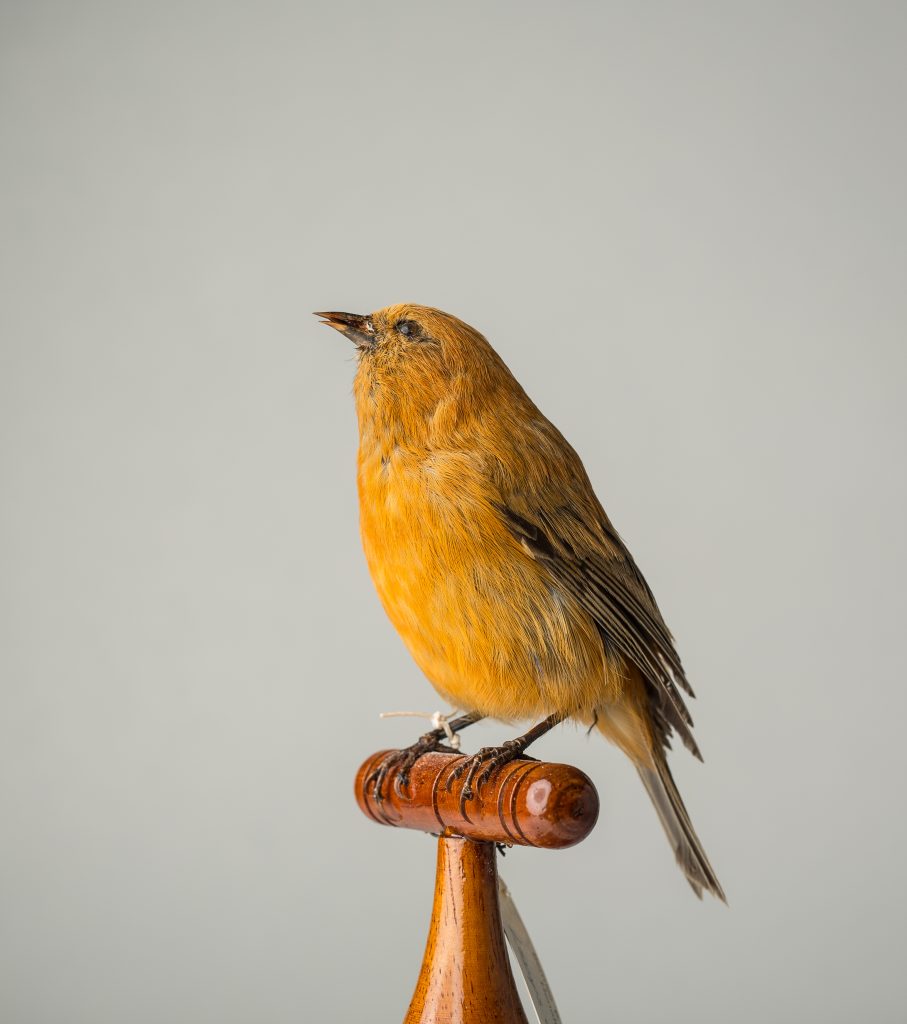Maui ʻĀkepa
Names
- ʻŌlelo Hawaiʻi: Maui ‘ākepa
- Scientific: Loxops coccineus ochraceus
Conservation Status
- Presumed Extinct
- Federally Listed as Endangered
- State Listed as Endangered
- State Recognized as Endemic
- NatureServe Heritage Rank G1/TH— Critically Imperiled/Subspecies Possibly Extinct
- IUCN Red List Ranking—Endangered
- Revised Recovery Plan for Hawaiian Forest Birds—USFWS 2006
Species Information
The Maui ‘ākepa is a small, insectivorous Hawaiian honeycreeper (Family: Fringillidae) endemic to the island of Maui and presumed to be extinct, last confirmed sighting was in 1988 (UH PCSU, 2021). There are other ‘Ākepa species found on the island of Hawai‘i (L. c. coccineus) and O‘ahu (L. c. rufus); the latter subspecies is extinct. Currently, all ‘ākepa are considered one species, with the Maui ʻākepa recognized as critically imperiled at the subspecies level. Adults are less colorful compared to the Hawai‘i ‘ākepa, and there is no information on the plumage sequence of the Maui subspecies. The lower mandible of the ‘ākepa is slightly bent to one side which results in the mandible tips being offset; a characteristic shared with the ‘akeke‘e (L. caeruleirostris) and the Hawai‘i ‘ākepa. Although almost nothing is known about its life history, the Maui ‘ākepa likely forages in a similar manner to the Hawai‘i ‘ākepa, and is most often observed in ‘ōhi‘a (Metrosideros polymorpha) forests. Although based on a single observation, in stark contrast to the Hawai‘i ‘ākepa, the Maui subspecies apparently builds an open-cup nest in the terminal foliage of ‘ōhi‘a trees.
Distribution
Unknown. Probably extinct. Last sightings occurred on the northeastern slopes of Haleakalā between 1,700 and 2,000 meters (5,500 – 7,000 feet) elevation in 1988 (UH PCSU, 2021). Historical distribution is poorly known, but like many Hawaiian forest birds the original range likely included all forested regions of the island.
Habitat
Virtually all sightings of the Maui ‘ākepa in this century were in wet montane ‘ōhi‘a forests on the northeastern slopes of Haleakalā. These forests vary from intact to degraded. Areas where the Maui ‘ākepa have most recently been observed are managed by the State of Hawai‘i or by the National Park Service.
Threats
Unknown. However, the Maui ‘ākepa was likely susceptible to the same factors that threaten other native Hawaiian forest birds including loss and degradation of habitat, predation by introduced mammals, and introduced disease. For Maui ‘ākepa, the following was likely of particular concern:
- Disease. The precipitous decline of the Maui and O‘ahu subspecies and the restriction of the Hawai‘i ‘ākepa to high-elevation forests suggests that disease played an important role in the demise of Maui ‘ākepa.
Photos
Additional Resources
For more information and references visit the DLNR State Wildlife Action Plan factsheets. DOFAWʻs species pages and State Wildlife Action Plan fact sheets are provided for general information and are not meant to be a citable, original source of data. If you are a student, researcher, or writer looking for a citable source, please explore the references below or find other original data sources, rather than citing these webpages. The references below were provided by the authors of the State Wildlife Action Plan fact sheets at the time of drafting:
- IUCN Red List of Threatened Species. 2015. Version 2014.3. Available at: www.iucnredlist.org. (Accessed May 2015).
- Lepson JK, Freed LA. 1997. ‘Akepa (Loxops coccineus). In The Birds of North America, No. 294 (Poole A, Gill F, editors.). Philadelphia, (PA): The Academy of Natural Sciences; and Washington DC: The American Ornithologists’ Union.
- Scott JM, Mountainspring S, Ramsey FL, Kepler CB. 1986. Forest bird communities of the Hawaiian islands: their dynamics, ecology and conservation. Lawrence, (KS): Cooper Ornithological Society.
- U.S. Fish and Wildlife Service. 2006. Revised Recovery plan for Hawaiian forest birds. Portland, (OR): U.S. Fish and Wildlife Service.





